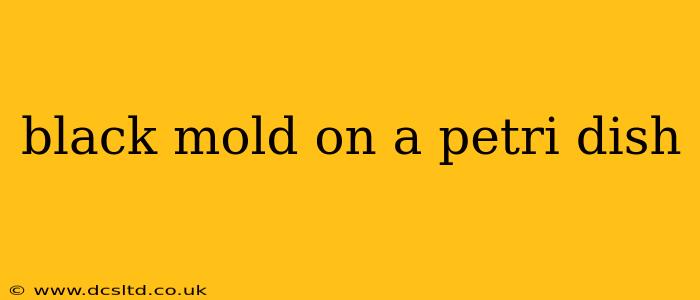Black mold—a term often used colloquially to describe various dark-colored fungi—can be a concerning sight, especially when appearing unexpectedly on a petri dish. This article delves into the identification, growth conditions, and safety precautions surrounding black mold found in petri dish cultures. We'll explore common questions surrounding this topic, providing accurate and informative answers backed by scientific understanding.
What causes black mold to grow on a petri dish?
Black mold growth on a petri dish indicates the presence of fungal spores in the environment. These spores, ubiquitous in the air, can land on the nutrient-rich agar within the dish. Favorable conditions—temperature, humidity, and nutrient availability—trigger germination and subsequent growth. Improper sterilization techniques during petri dish preparation or contamination from the surrounding environment are the most common culprits. Specific fungal species, including Stachybotrys chartarum (often referred to as "black mold," though many other species appear dark), Aspergillus niger, and various other Alternaria species, are frequently observed. The exact species will influence the specific shade of black and growth patterns.
Is black mold on a petri dish dangerous?
The danger posed by black mold growing on a petri dish depends entirely on the specific species involved and the handling practices. While many dark-colored fungi are not inherently toxic, some, like Stachybotrys chartarum, can produce mycotoxins under specific conditions. These toxins can cause adverse health effects if inhaled or ingested. Aspergillus niger, though typically not considered highly toxic, can cause aspergillosis in immunocompromised individuals. Therefore, it's crucial to handle petri dishes containing black mold with extreme care, wearing appropriate personal protective equipment (PPE) such as gloves and a mask, and following proper disposal procedures to avoid accidental exposure. Never attempt to identify the mold yourself; consult a mycologist or microbiologist for accurate identification.
How do you identify black mold on a petri dish?
Identifying black mold species requires microscopic examination and often advanced laboratory techniques. Visual inspection alone is insufficient for accurate identification. The color, texture, and growth pattern offer preliminary clues, but definitive identification necessitates microscopic analysis to observe spore morphology and other structural characteristics. This work is best left to trained professionals in microbiology or mycology laboratories.
What are the safety precautions when dealing with black mold on a petri dish?
Handling petri dishes with suspected black mold requires stringent safety precautions. Always wear gloves and a respirator mask (ideally an N95 or better) to prevent inhalation of spores. Work in a well-ventilated area or under a biological safety cabinet (BSC) to minimize exposure. After handling the petri dish, properly decontaminate all surfaces and equipment using an appropriate disinfectant (e.g., bleach solution). Finally, dispose of the petri dish and any contaminated materials according to institutional or local guidelines for biohazardous waste.
How can you prevent black mold from growing on a petri dish?
Preventing black mold growth begins with proper sterilization techniques. Thoroughly sterilize all equipment and media used in petri dish preparation using an autoclave. Work in a clean and sterile environment to minimize the introduction of spores. Properly seal the petri dishes to prevent contamination from airborne spores. Store petri dishes under appropriate conditions to avoid excessive moisture that promotes fungal growth.
Can black mold on a petri dish be treated?
Treatment isn't typically feasible once black mold is established on a petri dish. The best approach is prevention through meticulous sterilization and aseptic techniques. If contamination occurs, proper disposal is crucial to prevent further spread and risk of exposure. There are no effective treatments that would be safe and practical for treating mold contamination in a petri dish setting.
This information is for educational purposes only and should not be considered medical or professional advice. Always consult with a qualified professional for any concerns regarding mold exposure or identification.
